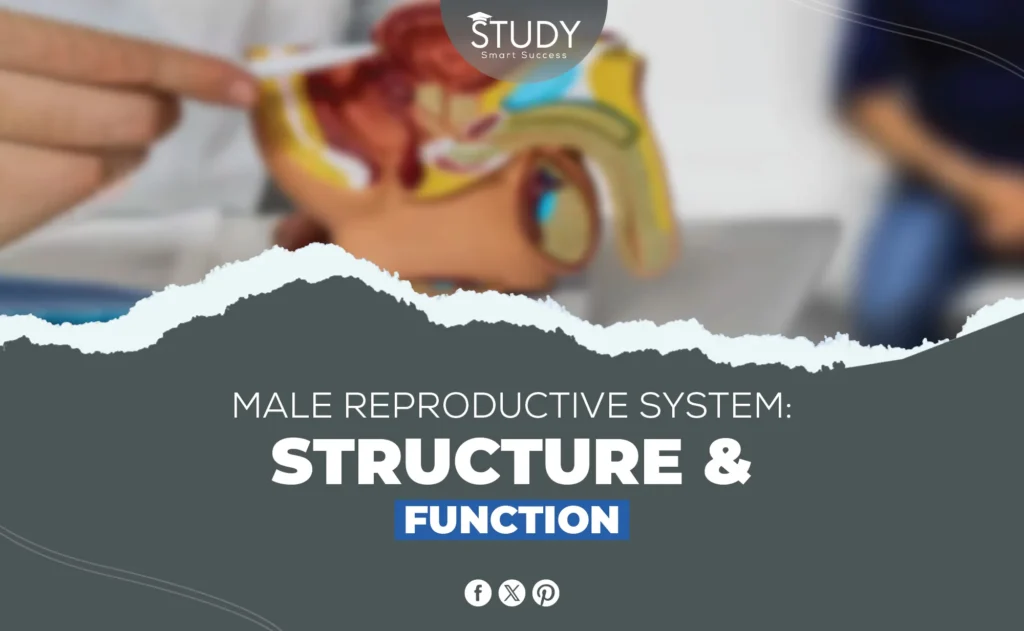Introduction
The male reproductive system comprises many parts and structures that work together to ensure that human life continues through reproduction. This system not only makes, stores, and moves sperm, which are the male gametes, but it also plays an integral part in the release of hormones, especially testosterone, which is needed for male sexual growth and reproduction.
In human biology, fully understanding the shape and function of the male reproductive system is essential because it helps us understand how male fertility is controlled and maintained. This information also shows how vital reproductive health is to men’s general health, making it an essential subject for health and education discussions.
Anatomy of the Male Reproductive System
The male reproductive system consists of principal and accessory organs, each playing a different role in reproduction.
Primary Organs
Testes: Males’ primary reproductive organs are the testes or gonads. They produce sperm for fertilization and testosterone, which develops male secondary sexual traits. The scrotum, a sac outside the body, protects the oval testes. This external positioning keeps the testes somewhat lower than the body’s core temperature, which optimizes sperm production.
Spermatogenesis takes place in the seminiferous tubules of the testes. Here, immature sperm cells undergo several stages of growth before they become fully grown spermatozoa.
Accessory Organs
- Epididymis: The epididymis is a long tube wound around itself and sits on top of each testis. In this structure, sperm are stored and grow up. Once sperm are made in the testes, they are moved to the epididymis and mature there for a few days. During this time, they learn to move around and fertilize an egg, an essential step for reproduction.
- Vas Deferens: The muscular tube vas deferens connects the epididymis to the urethra. The smooth muscle in the vas deferens walls contracts during ejaculation, driving sperm from the epididymis to the urethra, where they create semen with seminal fluid. During sexual interaction, sperm must be transported from the male to the female reproductive system.
- Seminal Vesicles: Both seminal vesicles are glands behind the bladder. They produce a thick, alkaline fluid with fructose and other nutrients and protection for sperm, increasing semen volume. This fluid neutralizes the female reproductive tract’s acidity, making it easier for sperm to survive and reach the egg.
- Prostate Gland: The walnut-sized prostate gland is below the bladder and in front of the rectum. It covers the urethra and produces a milky fluid that forms semen. Enzymes, prostate-specific antigen (PSA), and other compounds in this fluid improve sperm motility and lifespan, keeping them viable in the female reproductive system.
- Bulbourethral Glands: The little, pea-sized Cowper’s glands are on either side of the urethra below the prostate. These glands emit a transparent, slick fluid preceding ejaculation during sexual stimulation. By lubricating the urethra and neutralizing acidic urine, this fluid protects sperm during ejaculation.
Structure of the Penis
The penis is the male reproductive part that you can see from the outside. It has both sexual and urinary functions.
- Corpus Cavernosum and Corpus Spongiosum: The penis has three erectile tissue columns: two corpus cavernosum columns that lay parallel to each other on the dorsal side and a corpus spongiosum column that surrounds the urethra and forms the glans. The penis erects when these tissues swell with blood during sexual stimulation. Sexual activity requires this erection to allow the penis to enter the female reproductive tract and deliver sperm.
- Glans Penis: The head of the penis, or glans, is susceptible because it has a lot of nerve ends. It is an essential part of sexual joy and arousal and adds to the whole experience. In men who haven’t been circumcised, the foreskin covers the glans. During sexual activity, the foreskin can be pulled back to reveal the glans.
- Urethra: The urethra is a tube that runs the length of the penis and has two jobs. It lets pee leave the bladder and lets semen leave the body during an orgasm. Some muscles, called sphincters, control the urethra’s ability to do both jobs. They make sure that pee and semen stay separate while they do their jobs.
Spermatogenesis
Spermatogenesis is the process by which sperm are made in the testes. The seminiferous tubules are home to this complicated process, which includes several cell division and maturation steps.
- Spermatogonia: Spermatogonia is an immature germ cell living outside the seminiferous tubules. They are the first step in spermatogenesis. By going through mitosis, these cells constantly make new spermatogonia, and some of them also change into main spermatocytes.
- Primary and Secondary Spermatocytes: The main spermatocytes divide for the first time during meiosis, making two secondary spermatocytes, each with half as many chromosomes. The secondary spermatocytes then go through a second meiotic division, making spermatids, sperm cells that are not fully grown yet.
- Spermatids: Spermatids undergo a process called spermiogenesis, during which they change much about their shape. For example, they get a tail called a flagellum, and their nuclear material gets smaller. A change happens that makes spermatozoa, which are developed sperm cells. These cells are then released into the seminiferous tubules and taken to the epididymis to finish maturing.
Hormonal Regulation
Hormones, especially those made by the brain, pituitary gland, and testes, play a significant role in controlling the male reproductive system.
- GnRH (Gonadotropin-Releasing Hormone): The hypothalamus pulse releases GnRH, which tells the anterior pituitary gland to release LH and FSH, two essential hormones.
- LH (Luteinizing Hormone) and FSH (Follicle-Stimulating Hormone): LH goes straight to the Leydig cells in the testes and tells them to make testosterone. On the other hand, FSH works on the Sertoli cells inside the seminiferous tubules to help make sperm mature.
- Testosterone: Testosterone, the primary male sex hormone, causes secondary sexual traits like facial hair, voice deepening, and muscle growth. Maintaining libido, spermatogenesis, and male reproductive organ health is also essential. A negative feedback loop keeps testosterone levels in reproductive health ranges.
Function of the Male Reproductive System
The main job of the male reproductive system is to make, store, and send sperm so that eggs can be fertilized. It also produces hormones that keep male traits and reproductive health in good shape.
Sperm Production and Transport
Testicular spermatogenesis begins at puberty and continues throughout a man’s life. After production, sperm develop in the epididymis and travel into the vas deferens during ejaculation. The vas deferens’ smooth muscle contractions and accessory gland seminal fluids mix sperm into semen and release it through the urethra during sexual activity.
Hormonal Functions
For men, testosterone is the primary hormone that controls how they look and how they reproduce. It helps keep muscle mass, bone density, and desire up as an adult and encourages the development of secondary sexual traits during puberty. In addition, testosterone helps sperm grow and develop, which makes it an essential hormone for male development.
Fertilization Process
Semen enters the female reproductive system through ejaculation during sexual activity, starting fertilization. Sperm then moves through the cervix and uterus to the fallopian tubes, where they may fertilize an egg. The initial step in human life is the production of a zygote when sperm and egg mate.
Common Disorders of the Male Reproductive System
Several common diseases can affect a man’s reproductive system, which could affect his health and ability to have children.
- Erectile Dysfunction: Having erectile dysfunction (ED) means not being able to get or keep an erection long enough for a satisfying sexual encounter. Many things, such as heart disease, diabetes, hormonal changes, and mental health problems can cause ED.
- Prostate Disorders: Inflammation of the prostate, called prostatitis, benign prostatic hyperplasia (BPH), and prostate cancer are some of the diseases that can affect the prostate gland. These diseases can lead to symptoms like pelvic pain and trouble urinating, and in the case of prostate cancer, they may need significant medical help.
- Infertility: Male infertility can be caused by problems with sperm production, like not enough sperm, sperm that doesn’t move well, or sperm that doesn’t look right. It can also happen when the reproductive system gets blocked or hormones are out of balance, which stops spermatogenesis.
Conclusion
Male reproductive system anatomy and function are crucial to male health and fertility. Understanding how this system works helps people comprehend human reproduction and the relevance of reproductive health. A healthy lifestyle, balanced food, and regular checkups maintain the male reproductive system throughout a man’s life.


